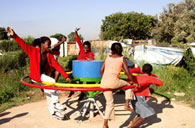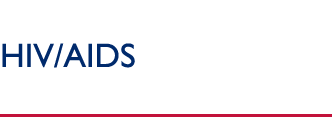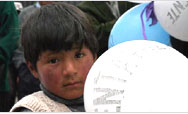Partnering to Fight AIDS
The U.S. Agency for International Development is a key partner in the U.S. President's Emergency Plan for AIDS Relief.
 |
The PlayPumps™ water system brings clean
drinking water into local communities.
On September 20, 2006, First Lady Laura Bush
announced that the U.S. Government, through USAID
and PEPFAR, will contribute $10 million toward a
partnership to bring clean water to 10 sub-Saharan
African countries, focusing in particular on
communities affected by HIV/AIDS.
Learn more |
The Promise of Partnerships
Partnerships – large and small, public and private, multilateral and bilateral
– are a key ingredient in the global fight against HIV/AIDS. For 45 years,
the U.S. Agency for International Development (USAID) has provided
assistance to developing countries through a vast network of organizations,
including international bodies, nongovernmental organizations (NGOs),
businesses, universities, and indigenous groups. With the advent of the
U.S. President’s Emergency Plan for AIDS Relief, a $15 billion initiative to fight HIV/AIDS around the world, the United States now leads the world in its level of support to fight
HIV/AIDS. Accordingly, USAID and its partners are working through the
Emergency Plan to expand the quality of HIV/AIDS prevention, care, and
treatment programs.
USAID works with HIV/AIDS partners in three primary ways:
- Through traditional USAID funding mechanisms that support NGOs
(i.e., grantees and contractors), a number of which are community- and
faith-based groups
- Through public international organizations, such as the Global Fund
to Fight AIDS, Tuberculosis and Malaria
- Through distinct collaborative agreements or public-private partnerships
with businesses and multinational corporations
Partnering with Host Nations: South Africa Focus
|
Quick Facts |
|
The U.S. President’s Emergency Plan for AIDS
Relief has HIV/AIDS partnerships in more than
120 developing countries, with a special focus
on 15 hard-hit nations.
More than 80 percent of 1,200 Emergency Plan
partners are indigenous organizations.
Building capacity and sustainability for
HIV/AIDS field programs is essential to
Emergency Plan partnerships.
|
|
Since the late 1990s, USAID has played an instrumental role in
bringing the internationally famous Sesame Street children’s
television series to South Africa. Working with the South African
Broadcasting Corporation and Sesame Workshop, USAID
developed and produced Takalani Sesame, the South African
version of Sesame Street. USAID also supported the training of
local producers to adapt the show for radio to reach millions of
South African children without access to televisions. In 2002,
Takalani Sesame reached a milestone with the debut of Kami, the
first HIV-positive Muppet. In 2005, Takalani Sesame received the
Governor of Tokyo Prize in the prestigious Japan Prize Contest,
which honors media that contribute to the advancement of
educational television around the world.
Some Key USAID HIV/AIDS Partners
Support for Nongovernmental Organizations (Traditional USAID Grantees and Contractors)
- Supply Chain Management System. The Supply Chain Management System project, an Emergency Plan funded project administered by USAID, delivers essential lifesaving medicines and supplies to the front lines of HIV/AIDS programs
around the world. The project is strengthening existing supply chains and helping to establish new ones to ensure a safe, secure, reliable, and sustainable supply chain management system to procure pharmaceuticals and other products for
people with HIV/AIDS and related infections.
- New Partners Initiative. The Emergency Plan’s New Partner’s Initiative, administered by USAID, is providing $200
million to faith- and community-based organizations to implement HIV/AIDS prevention and care services.
Support for Public International Organizations
- Global Fund to Fight AIDS, Tuberculosis and Malaria. With President George W. Bush’s pledge to contribute $1 billion
over five years beginning in 2004, the United States is the Global Fund’s largest donor. By the end of 2006, the United
States will already have exceeded the President’s initial pledge, bringing the aggregate U.S. contribution to the Fund to
over $2 billion. USAID provides staff support to the Fund and works with its local coordinating committees to improve
implementation of Fund programs and their complement to U.S. Government programs.
Support for Public-Private Partnerships
- Pfizer Global Health Fellows. USAID works behind the scenes to establish assignments for Pfizer’s Global Health
Fellows program, which loans personnel worldwide to NGOs and ministries of health for the President’s Emergency
Plan for AIDS Relief. Along with health care personnel, Pfizer loans financial and organizational management experts
who support partner NGOs and local ministries in strengthening health systems. As a result of Pfizer loaning a fellow
with expertise in financial management, the Mothers-to-Mothers-to-Be Program (M2M2B) in Cape Town, South Africa,
was able to open 15 new sites and is planning 17 more.
- Coca-Cola. USAID partners with the Coca-Cola Company, which works in 56 of 57 countries in Africa and is the
largest private sector employer on the continent. This alliance supports HIV/AIDS treatment, prevention, and care for
the employees of Coca Cola bottlers and their families. The alliance also supports community outreach initiatives,
including job creation, for orphans and youth affected by AIDS.
- International AIDS Vaccine Initiative (IAVI). Through a collaborative agreement, IAVI and USAID are building in-country
capacity to improve significantly how HIV vaccine candidates are developed and prioritized; to perform clinical
research trials in developing countries; and to implement public policies that aid in the acceleration and support of HIV
vaccine research and development.
A Winning Model of Partnership: USAID’s Global Development Alliance
Since 2001, USAID has multiplied the impact of its development programs through the banner of the Global
Development Alliance (GDA), the Agency’s main public-private partnership office. Already demonstrating impressive
results, GDA has obligated $1.4 billion to more than 400 public-private alliances through 68 USAID Missions and has
leveraged more than $4.6 billion in partner contributions. Through workshops and trainings around the globe, more
than 1,000 USAID professionals have been trained on public-private alliance building. These trained USAID professionals
have brought new and exciting resources to the table. Through these GDA alliances, USAID has gained additional
financial resources for development activities, as well as new technologies, intellectual capital, and technical and
managerial expertise. Due to these remarkable successes, GDA was a finalist for the prestigious Ash Institute's
Innovation in American Government Award from Harvard University's Kennedy School of Government. In November
2005, GDA was also named the inaugural winner of the Lewis & Clark Award for Innovation in Collaborative
Governance, which celebrates real-world success in collaborative governance and advances scholarship by highlighting
noteworthy examples for analysis.
|
November 2006
|


